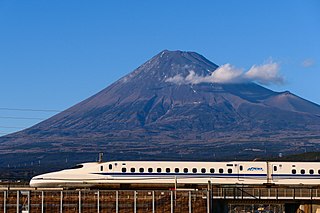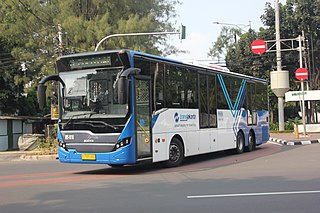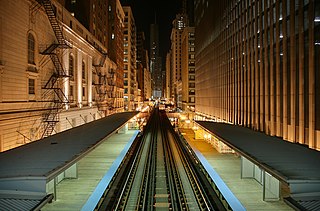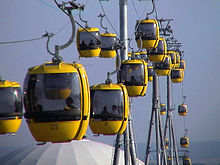
Rail transport is a means of transport using wheeled vehicles running in tracks, which usually consist of two parallel steel rails. Rail transport is one of the two primary means of land transport, next to road transport. It is used for about 8% of passenger and freight transport globally, thanks to its energy efficiency and potentially high speed.

A train is a series of connected vehicles that run along a railway track and transport people or freight. Trains are typically pulled or pushed by locomotives or railcars, though some are self-propelled, such as multiple units. Passengers and cargo are carried in railroad cars, also known as wagons. Trains are designed to a certain gauge, or distance between rails. Most trains operate on steel tracks with steel wheels, the low friction of which makes them more efficient than other forms of transport.

Transport in the United Kingdom is highly facilitated by road, rail, air and water networks. Transport is a devolved matter with each of the countries of the United Kingdom having separate systems under separate governments.

High-speed rail (HSR) is a type of rail transport network utilizing trains that run significantly faster than those of traditional rail, using an integrated system of specialized rolling stock and dedicated tracks. While there is no single standard that applies worldwide, lines built to handle speeds above 250 km/h (155 mph) or upgraded lines in excess of 200 km/h (125 mph) are widely considered to be high-speed.

Personal rapid transit (PRT), also referred to as podcars or guided/railed taxis, is a public transport mode featuring small low-capacity automated vehicles operating on a network of specially built guideways. PRT is a type of automated guideway transit (AGT), a class of system which also includes larger vehicles all the way to small subway systems. In terms of routing, it tends towards personal public transport systems.

Light rail transit (LRT) is a form of passenger urban rail transit characterized by a combination of tram and rapid transit features. While its rolling stock is similar to that of a traditional tram, it operates at a higher capacity and speed and often on an exclusive right-of-way. In many cities, light rail transit systems more closely resemble, and are therefore indistinguishable from, traditional underground or at-grade subways and heavy-rail metros.

The West Coast Main Line (WCML) is one of the most important railway corridors in the United Kingdom, connecting the major cities of London and Glasgow with branches to Birmingham, Manchester, Liverpool and Edinburgh. It is one of the busiest mixed-traffic railway routes in Europe, carrying a mixture of intercity rail, regional rail, commuter rail and rail freight traffic. The core route of the WCML runs from London to Glasgow for 399 miles (642 km) and was opened from 1837 to 1881. With additional lines deviating to Northampton, Birmingham, Manchester, Liverpool and Edinburgh, this totals a route mileage of 700 miles (1,127 km). The Glasgow–Edinburgh via Carstairs line connects the WCML to Edinburgh. However, the main London–Edinburgh route is the East Coast Main Line. Several sections of the WCML form part of the suburban railway systems in London, Coventry, Birmingham, Manchester, Liverpool and Glasgow, with many more smaller commuter stations, as well as providing links to more rural towns.

Railway signalling (BE), or railroad signaling (AE), is a system used to control the movement of railway traffic. Trains move on fixed rails, making them uniquely susceptible to collision. This susceptibility is exacerbated by the enormous weight and inertia of a train, which makes it difficult to quickly stop when encountering an obstacle. In the UK, the Regulation of Railways Act 1889 introduced a series of requirements on matters such as the implementation of interlocked block signalling and other safety measures as a direct result of the Armagh rail disaster in that year.

Bus rapid transit (BRT), also referred to as a busway or transitway, is a bus-based public transport system designed to have much more capacity, reliability and other quality features than a conventional bus system. Typically, a BRT system includes roadways that are dedicated to buses, and gives priority to buses at intersections where buses may interact with other traffic; alongside design features to reduce delays caused by passengers boarding or leaving buses, or paying fares. BRT aims to combine the capacity and speed of a light rail transit (LRT) or mass rapid transit (MRT) system with the flexibility, lower cost and simplicity of a bus system.
Skip-stop is a public transit service pattern which reduces travel times and increases capacity by having vehicles skip certain stops along a route. Originating in rapid transit systems, skip-stop may be also used in light rail and bus systems.

A double-track railway usually involves running one track in each direction, compared to a single-track railway where trains in both directions share the same track.

Urban rail transit is a wide term for various types of local rail systems providing passenger service within and around urban or suburban areas. The set of urban rail systems can be roughly subdivided into the following categories, which sometimes overlap because some systems or lines have aspects of multiple types.
Various terms are used for passenger railway lines and equipment; the usage of these terms differs substantially between areas:
Headway is the distance or duration between vehicles in a transit system measured in space or time. The minimum headway is the shortest such distance or time achievable by a system without a reduction in the speed of vehicles. The precise definition varies depending on the application, but it is most commonly measured as the distance from the tip of one vehicle to the tip of the next one behind it. It can be expressed as the distance between vehicles, or as time it will take for the trailing vehicle to cover that distance. A "shorter" headway signifies closer spacing between the vehicles. Airplanes operate with headways measured in hours or days, freight trains and commuter rail systems might have headways measured in parts of an hour, metro and light rail systems operate with headways on the order of 90 seconds to 20 minutes, and vehicles on a freeway can have as little as 2 seconds headway between them.
In public transportation, schedule adherence or on-time performance refers to the level of success of the service remaining on the published schedule. On time performance, sometimes referred to as on time running, is normally expressed as a percentage, with a higher percentage meaning more vehicles are on time. The level of on time performance for many transport systems is a very important measure of the effectiveness of the system.
Passengers per hour per direction (p/h/d), passengers per hour in peak direction (pphpd) or corridor capacity is a measure of the route capacity of a rapid transit or public transport system.

Railway electrification in Iran describes the past and present electrification systems used to supply traction current to rail transport in Iran with a chronological record of development, a list of lines using each system, and a history and a technical description of each system.

France has a large network of high-speed rail lines. As of June 2021, the French high-speed rail network comprises 2,800 km (1,740 mi) of tracks, making it one of the largest in Europe and the world. As of early 2023, new lines are being constructed or planned. The first French high-speed railway, the LGV Sud-Est, linking the suburbs of Paris and Lyon, opened in 1981 and was at that time the only high-speed rail line in Europe.

Communications-based train control (CBTC) is a railway signaling system that uses telecommunications between the train and track equipment for traffic management and infrastructure control. CBTC allows a train's position to be known more accurately than with traditional signaling systems. This makes railway traffic management safer and more efficient. Metros are able to reduce headways while maintaining or even improving safety.

A crush load is a level of passenger loading in a transport vehicle which is so high that passengers are "crushed" against one another. It represents an extreme form of passenger loading, and normally considered to be representative of a system with serious capacity limitations. Crush loads result from too many passengers within a vehicle designed for a much smaller number. Crush loaded trains or buses are so heavily loaded that for most passengers physical contact with several other nearby passengers is impossible to avoid.
















